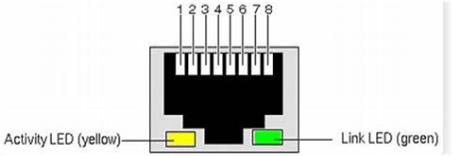Troubleshooting Network Discovery Issues.
Pease read this FAQ to understand how the on-board LED indicator on the e-Node can assist you with troubleshooting network problems.
Important Topics that should be considered follow below:
- Network Router/LAN Cable or Crimp problems.
In general, if the e-Node's indicator continues flashing 2x per second GREEN after a reboot, this indicates network wiring, network switch, network router or crimping issues with LAN cables. Try another port on your router/switch with another known good network cable. If you are using the e-Node 4x00 device with POE, try substituting a 12v wall wart and disconnect the device from a powered POE port (simply adding a wall-wart without disconnecting the e-node from a powered POE switch will not remove the POE component from the equation that we are testing).

- Is the e-Node LED indicator stuck in the Flashing Green 2x/second mode?
There may be noise within the system that is impacting the ability of the e-Node to successfully negotiate a network connection. Following are several issues that might be the cause of this noise. First, if you are not using twisted pair CS-BUS wiring with the right twisted pairs corresponding to specific pins, or if there are no grounds on all of the ILC-xx0 devices connected to the e-Node, communication may be impacted. Typically, we have seen noise being induced into the system when non-twisted pair wiring (like flat oval telephone cable is used) or if when there is CS-Bus, if splits in the bus such as the use of splitters ("Y" connectors) can be seen. These out-of-spec wiring methods will certainly induce noise into the system. It is important that CS-BUS wiring have twisted pairs on pins 1/2, 3/4 and 5/6. If you have used T568A or T568B and have just cutoff the BROWNS this is a big no-no. You will notice that with either of these wiring schemes there are no twisted pairs present on pins 3/4 which is critical for trouble-free communication and/or no noise introduced into the system. If any of these situations have been found to exist, simply correct the issues, reboot the e-Node (to flush its buffers from noise) and try again.

- Network glitches
A simple solution for some installations is to simply reboot the e-Node and/or turn off your router and/or switches to see if this remedies the issues.
- Are you experiencing any ARP Floods on your network that might cause connectivity/performance issues?
Use WireShark or similar network snooping software and troubleshoot your network. It is highly likely that there are serious network ARP Floods which are impacting the successful connection of the e-Node to your system. We see this all the time and Wireshark is a great tool to troubleshoot these issues. If you are experiencing network issues, you can always try to separate the e-Node using a VLAN (and just keep mandatory subsystems such as Lutron or other 3rd party automation system on the same VLAN that all talk to each other). You can download Wireshark for free at www.wireshark.org. In addition, here is an excellent article discussing ARP Floods which may be helpful to you.
- Is the e-Node' LED indicator showing a Solid RED LED (after initial boot-up where is just flashes momentarily).
This typically means that during a firmware update there was corruption in the data received. If the e-Node is left in this state, no communication with the unit is possible and therefore until the situation is resolved, no further troubleshooting steps should be pursued. In this case, refer to this document to resolve this issue.
